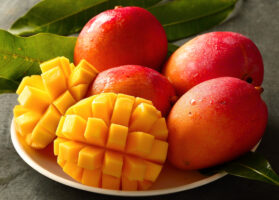Peak volume season is here on Mexican mangoes
Overview of mangos from Mexico in the U.S. market, complemented by charts from Agronometrics. Original published on May 23, 2023.
Mexican mango supplies are starting to hit peak season. “May has seen a steady supply of mangoes–with the heat, the fields are ready. The cornstarch is turning into sugar faster so there’s the best quality right now,” says Rodrigo Diaz of Rio Rico, AZ-based Diazteca.
Currently, the company is harvesting Tommy Atkins, which are peaking on sizes 9s and 10s, and Ataulfo (Honey) mangos, peaking on size 18s. “The last couple of years, May has seen a lower volume of mango overall. This year though the supply is strong and steady and the quality is great. We’re seeing a good May and we will have a good June and July as well,” says Diaz.
The majority of mango supplies are currently from Mexico. There is some volume from Guatemala and some from the Dominican Republic as well. Peru, one of the most significant mango-supplying countries aside from Mexico, ended its season two weeks ago.

Source: USDA Market News via Agronometrics.
(Agronometrics users can view this chart with live updates here)
As supplies grow, so does demand, particularly as temperatures warm up outside and consumers are heading out and into their retailers more often as well. At the same time, promotion and education efforts from organizations such as the National Mango Board also help. “While their promotions target mostly fresh mango consumption, awareness and education on how to ripen a mango and cut it and the nutrition benefits of mango have increased demand in the industry. Restaurants are using more mango and frozen, pureed and dried mango have also seen increased demand,” says Diaz.
Economic concerns
While pricing is higher in larger mango sizes and lower on smaller fruit, Diaz notes the industry continues to be challenged by uncontrolled economic variables. Namely, production-related materials such as fertilizers, have increased by 25 percent overall across the industry while pricing on mangos has only grown by seven percent annually. At the same time, the exchange rate of Mexican Pesos to the U.S. Dollar offers up an additional 13 percent difference. “In all, the margin has shrunk as an industry,” he says.
That said, looking ahead, Diazteca has some development in its mango production coming. New mango fields planted in 2016 in Oaxaca have strengthened Diazteca´s supply of mangos from that region, particularly in the early part of the Mexican deal stretching from February to April. At the same time, in southern Sinaloa, where the company has 2,000 acres planted, in one to two years, the region will have a new water dam in place. “That will allow 100-200 percent greater yield in overall production from that region. Right now there’s no water dam in southern Sinaloa,” he says.
The News in Charts is a collection of stories from the industry complemented by charts from Agronometrics to help better tell their story.
Access the original article with this (Link)






